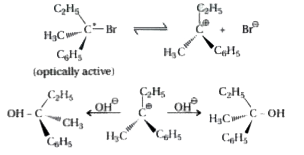Write a note on SN1 reaction. Solution in Gujrati
The reaction in which the rate is independent of concentration of nuclephile and depends only on the concentration of substrate is called SN1 reaction. Thus SN1 reaction follows first order kinetics.
(CH3)3C−Br+−OH→(CH3)3C−OH+Br−
Rate α[(CH3)3C−Br]
The SN1 reaction takes place in two steps :
Step - 1 : The polarised C - Br bond undergoes cleavage slowly to form a carbocation and a bromide ion. The carbocation thus formed is then attacked by nucleophile in step - II to complete the substitution reaction.
CH3−CH3| C | CH3−Br Slow ⇐==⇒CH3−CH3| C⊕| CH3+BrΘ
The step - 1 is the slow and reversible and thus it is a rate determining step. The energy required for breaking of C - Br bond is obtained through solvantion of halide ion with the proton of a protic solvent. The rate of reaction depends only on concentration of alkyl halide and not on the concentration of −H ion because slow step involves only the alkyl halide.
Step - 2 : The carbocation being planar is attacted from either side by nucleophile to form a final product. It is a fast step.
CH3−CH3| C⊕| CH3+өOH Fast −−−→CH3−CH3| C | CH3−OH
In case if the substrate is optically active, the SN1 reaction results in partial racemisation. Due to planar structure of carbocation, the nucleophile attacks from either side to give enantiomers. The attack from backside is more favourable and thus the enantiomers are not obtained in equal amount.

For the given alkyl group the reactivity of alkyl halides follow the order.
R−I>R−Br>R−Cl>R−F
Topper's Solved these Questions
- BOOK - KUMAR PRAKASHANCHAPTER - HALOALKANES AND HALOARENESEXERCISE - SECTION - B INTEXT QUESTIONS AND ANSWERS20videos
HALOALKANES AND HALOARENES
- BOOK - KUMAR PRAKASHANCHAPTER - HALOALKANES AND HALOARENESEXERCISE - SECTION - C TEXTUAL EXERCISE87videos
HALOALKANES AND HALOARENES
- BOOK - KUMAR PRAKASHANCHAPTER - HALOALKANES AND HALOARENESEXERCISE - SECTION - E Multiple Choice Questions260videos
HALOALKANES AND HALOARENES
- BOOK - KUMAR PRAKASHANCHAPTER - GENERAL PRINCIPLES AND PROCESSES OF ISOLATION OF ELEMENTSEXERCISE - SECTION - E (MCQs ASKED IN GUJET/BOARD EXAMS)46videos
GENERAL PRINCIPLES AND PROCESSES OF ISOLATION OF ELEMENTS
- BOOK - KUMAR PRAKASHANCHAPTER - POLYMERSEXERCISE - SECTION - E (MCQs asked in Board Exams)51videos
POLYMERS
Similar Questions
Write the structures of the following compounds :
2-Chloro-3-methylentane01:47View SolutionName the following halides according to IUPAC system and classify them as alkyl, allyl, benzyl (primary, secondary, tertiary), vinyl or aryl halides :
(CH3)2CHCH(Cl)CH302:55View SolutionThe derivatives that are not found in nature are …..
01:52View SolutionDuring electrolysis of aqueous solution of Na2SO4 using graphite electrode .........
04:04View SolutionWhich polymer is used in preparation of capsules ?
06:13View SolutionSN1 reaction is favoured by
08:38View SolutionSN1andSN2 reactions are
View SolutionWrite any two differences between S_(N^(2)) and S_(N^(1)) reaction.
View SolutionExplain the mechanism of S_(N^(1)) and S_(N^(2)) reactions with examples.
View SolutionWhat is the stereochemical result of S_(N)^(1) and S_(N) ^(2) reactions ?
01:54View SolutionSN1 reaction is favoured by _________.
01:40View SolutionCompare SN1andSN2 reaction mechanisms.
05:30View SolutionCompare S_(N^1)and S_(N^2 reaction mechanisms.
06:25View SolutionCompare SN1 and SN2 reaction mechanisms.
06:26View SolutionWrite one stereochemical difference between SN1 and SN2 reactions.
02:10View Solution

